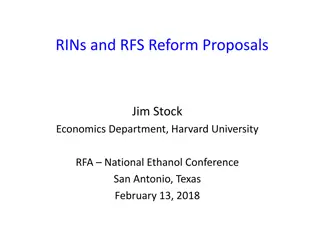
Quantifying Batch Effects and Recursive Variance Partitioning Research
Explore the research on quantifying batch effects in data sets with small sample sizes using methods like PVCA, gPCA, k-BET, and LISI. Learn about Recursive Variance Partitioning (RVP) for measuring variance due to batch effects, with examples from simulated RNA-seq and real-world data sets.
Uploaded on | 0 Views
Download Presentation

Please find below an Image/Link to download the presentation.
The content on the website is provided AS IS for your information and personal use only. It may not be sold, licensed, or shared on other websites without obtaining consent from the author. If you encounter any issues during the download, it is possible that the publisher has removed the file from their server.
You are allowed to download the files provided on this website for personal or commercial use, subject to the condition that they are used lawfully. All files are the property of their respective owners.
The content on the website is provided AS IS for your information and personal use only. It may not be sold, licensed, or shared on other websites without obtaining consent from the author.
E N D
Presentation Transcript
Recursive variance partitioning: Quantifying batch effects Chan Wei Xin (weixin@u.nus.edu) Supervisor: Prof Wong Limsoon
Batch effects PC2 (8.04%) Adapted from: Korsunsky et al. (2019) PC1 (11.75%) PC3 (4.08%) Identified qualitatively by visualizing data through PCA, t-SNE and UMAP Systematic errors in measurements between different batches of samples Can be the result of many different factors
Quantifying batch effects Few methods have been proposed for data sets with small sample sizes PVCA (Scherer, 2009) gPCA (Reese et al., 2013) Methods designed for use in scRNA-seq data include: k-BET (Buttner et al., 2019) LISI (Korsunsky et al., 2019) Not robust to data with batch-class imbalance
Recursive variance partitioning (RVP) Robust to data with batch-class imbalance Measures the percentage of variance in data due to batch effects Based on the partition of sums of squares 19 batch value 1 2 18 A549 K562 class
Results Simulated RNA-seq data BatchQC package Raw counts are simulated using a negative binomial distribution Simulated 11 different data sets with different magnitudes of batch effects Two sets of data sets: Balanced and imbalanced Theoretical variance due to batch effects can be computed using the parameters that were used to simulate the RNA-seq data Empirical variance estimated by RVP to be due to batch effects 1.0e+12 Estimated batch effects variance Estimated batch effects variance 7.5e+11 2 1e+12 gPCA d * SX 2 PVCA * SX 2 gPCA d * SX 2 RVP * SX 5.0e+11 2 PVCA * SX 5e+11 2 RVP * SX 2.5e+11 0.0e+00 0e+00 0e+00 1e+11 2e+11 0e+00 1e+11 2e+11 Theoretical batch effects variance Theoretical batch effects variance
Results Real world data Microarray gene expression data Ma-Spore ALL data set MAQC-I data set Quantitative proteomics data Westlake data set Created balanced and imbalanced versions of these data sets by sub-sampling Created versions of these data sets with no batch effects by assigning samples from the same batch to different pseudo batches
Results Microarray data Ma-Spore ALL data set MAQC-I data set
Results Proteomics data Westlake data set
Runtime Simulated five data sets with different numbers of samples using the BatchQC package Number of samples: 2000, 4000, , 10000; Number of features: 8000 600 Metric Runtime (s) 400 RVP gPCA PVCA 200 0 2000 4000 6000 8000 10000 Number of samples
Conclusion RVP is an estimate of the proportion of variance in data that is due to batch effects RVP accurately quantifies the magnitude of batch effects across a wide range of magnitudes RVP is robust even when used on data with batch-class imbalance RVP is an order of magnitude faster than gPCA and PVCA Future work Compare RVP against batch effects metrics designed for scRNA-seq data Evaluate the effectiveness of RVP in quantifying batch effects in scRNA-seq data
Thank you! Q&A

